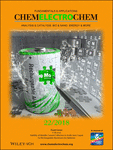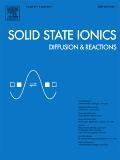
Battery Energy
Scope & Guideline
Connecting Researchers for a Sustainable Tomorrow.
Introduction
Aims and Scopes
- Battery Materials Development:
Research related to the synthesis and characterization of novel materials for various types of batteries, including lithium-ion, sodium-ion, and solid-state batteries. - Electrochemical Performance Optimization:
Studies aimed at enhancing the electrochemical performance of battery systems, focusing on improvements in capacity, cycling stability, and overall efficiency. - Energy Storage Systems Design:
Innovative designs and configurations of energy storage systems, including hybrid systems, supercapacitors, and next-generation battery architectures. - Sustainability and Recycling:
Research on the sustainable aspects of battery technologies, including recycling methods, second-life applications for batteries, and environmentally friendly materials. - Advanced Characterization Techniques:
Application of advanced techniques for characterizing battery materials and systems, including in situ and ex situ methods to understand their behavior under operational conditions. - Theoretical and Computational Studies:
Utilization of theoretical models and computational methods to predict and analyze the performance of battery materials and systems.
Trending and Emerging
- Solid-State Batteries:
There is a growing interest in solid-state battery technologies, which promise enhanced safety and energy density compared to traditional liquid electrolyte batteries. - Sodium-Ion Batteries:
Research on sodium-ion batteries is on the rise, driven by the need for alternative energy storage solutions that leverage abundant raw materials. - Recycling and Sustainability:
Emerging emphasis on recycling methods and sustainable practices in battery manufacturing and disposal, including studies on second-life applications for used batteries. - Advanced Electrode Materials:
Innovative materials for electrodes, such as nanostructured and hybrid materials, are being explored to improve the performance of various battery types. - Electrolyte Engineering:
Recent works are focusing on the development of novel electrolyte formulations, including solid and gel electrolytes, to enhance battery safety and performance. - Fast-Charging Technologies:
Research aimed at developing fast-charging capabilities for batteries is becoming increasingly prominent, addressing consumer demand for quicker charging solutions.
Declining or Waning
- Traditional Lead-Acid Battery Research:
Research focusing on lead-acid battery technologies has diminished, likely due to the increasing interest in lithium-ion and advanced battery systems that offer better performance and sustainability. - Basic Battery Chemistry Studies:
While foundational chemistry remains important, there is a noticeable decline in publications that focus solely on basic electrochemical principles without application to advanced battery technologies. - Single Material Battery Systems:
The emphasis on developing battery systems based on single material approaches is waning, as there is a shift towards hybrid materials and composite systems that enhance performance.
Similar Journals

JOURNAL OF THE ELECTROCHEMICAL SOCIETY
Driving Theoretical and Experimental Breakthroughs in ElectrochemistryJOURNAL OF THE ELECTROCHEMICAL SOCIETY, published by the ELECTROCHEMICAL SOCIETY INC, is a leading peer-reviewed academic journal dedicated to advancing the field of electrochemistry and its myriad applications. With an ISSN of 0013-4651 and E-ISSN of 1945-7111, this esteemed journal has been a pivotal platform for research since its inception in 1948, with convergence periods allowing for a rich historical context of study through to 2024. Recognized for its high impact, it holds a noteworthy Q1 ranking in several categories including Condensed Matter Physics and Materials Chemistry, and it is Q2 ranked in both Electrochemistry and Renewable Energy. This journal features a range of articles that encompass both theoretical and experimental advancements, making it a crucial resource for researchers, professionals, and students keen on exploring cutting-edge developments in materials science, energy solutions, and sustainable technologies. Although it is not an open access journal, its rigorous standards ensure that published work significantly contributes to the body of knowledge within its fields, fostering innovative research and collaborative progress.

Journal of Electrochemical Science and Technology
Fostering Knowledge in Electrochemical ApplicationsJournal of Electrochemical Science and Technology, with the ISSN 2093-8551, is a distinguished publication in the field of electrochemistry, disseminated by the Korean Electrochemistry Society. Based in South Korea, the journal has made significant strides since its inception in 2014, showcasing groundbreaking research that spans various applications of electrochemical science. Currently ranked in the Q2 category for Electrochemistry, it occupies an emerging position within the academic community, evidenced by its Scopus rank of #25 out of 60 in the Electrochemistry domain, placing it in the 59th percentile. Although the journal follows a traditional access model, it remains committed to providing high-quality, peer-reviewed content that fuels innovation and scholarly dialogue. With objectives firmly rooted in advancing the understanding and application of electrochemical phenomena, this journal serves as a crucial resource for researchers, professionals, and students alike, striving to push the boundaries of the electrochemical sciences.

Batteries & Supercaps
Transforming Energy Storage with Cutting-Edge ResearchBatteries & Supercaps is a leading international journal published by WILEY-V C H VERLAG GMBH, dedicated to the advancement of knowledge in the fields of electrical and electronic engineering, electrochemistry, and energy engineering. With a remarkable Q1 ranking in multiple relevant categories, including Electrical and Electronic Engineering, Electrochemistry, and Energy Engineering and Power Technology, this journal serves as a vital resource for researchers, professionals, and students alike who are exploring innovative solutions in energy storage and conversion technology. As the demand for more efficient storage systems continues to escalate, Batteries & Supercaps provides a platform for high-quality research articles, reviews, and technical notes that contribute to the evolution of this dynamic field. Accessible globally from Germany, the journal promises to cultivate an engaging academic discourse on battery technology and supercapacitors through insightful contributions from a diverse array of experts. Join us in shaping the future of energy solutions and explore groundbreaking findings that pave the way for sustainable innovations.

Batteries-Basel
Exploring Breakthroughs in Battery TechnologyBatteries-Basel, published by MDPI, is a premier open-access journal since 2015 that aims to serve the growing community focused on the technological advancements and innovations in battery science and related fields. Operating from its base in Switzerland, this journal publishes high-quality research covering the fields of Electrical and Electronic Engineering, Electrochemistry, and Energy Engineering and Power Technology. With a commendable Q2 ranking in multiple categories for 2023, it consistently strives to present cutting-edge studies, reviews, and practical applications that drive progress in energy storage technologies. Researchers and professionals will find invaluable insights within its pages, contributing to both theoretical understanding and practical deployment of battery technologies. Open access provides broad dissemination of knowledge, ensuring that discoveries reach a global audience, and fostering collaborative efforts to address the challenges posed by modern energy demands.

Journal of Physics-Energy
Pioneering Discoveries at the Intersection of Energy and MaterialsJournal of Physics-Energy, published by IOP Publishing Ltd, is a leading Open Access journal that serves as a dynamic platform for the dissemination of high-quality research within the interdisciplinary realms of energy, materials science, and materials chemistry. Since its inception in 2019, the journal has gained remarkable recognition, achieving a prestigious Q1 ranking in multiple categories in 2023, highlighting its impact within these rapidly evolving fields. With its Scopus Ranks, placing it in the top 10% of journals for General Energy and within the top 20% for Materials Science disciplines, it reflects the commitment to excellence in research and innovation. Conveniently based in the United Kingdom, the journal is designed to facilitate collaboration and knowledge exchange among researchers, professionals, and students dedicated to advancing the understanding of energy technologies and materials science. The open access model ensures that cutting-edge research is freely available, promoting global accessibility and engagement with the latest scientific advancements.

ACTA CHIMICA SINICA
Innovative Insights into the World of ChemistryACTA CHIMICA SINICA, published by SCIENCE PRESS, is a distinguished peer-reviewed journal in the realm of Chemistry, specifically focusing on general and miscellaneous chemistry fields. Since its inception in 1982, the journal has consistently contributed to the advancement of chemical research in China and beyond, maintaining a reputable standing within the academic community, evidenced by its 2023 Scopus ranking of #197 out of 408 in its category. With a current impact factor placing it in the Q3 quartile, ACTA CHIMICA SINICA aims to disseminate innovative research findings, covering a wide spectrum of topics within the discipline. Although it is not an open-access journal, it offers various access options through institutional subscriptions, ensuring that its high-quality content is available to a broad audience. Researchers, professionals, and students alike will find this journal a vital resource for keeping abreast of developments in the field and for contributing their own findings to an engaged scientific community.

ChemElectroChem
Unlocking innovative solutions for a sustainable future.ChemElectroChem is a premier open-access journal published by WILEY-V C H VERLAG GMBH, focusing on the interdisciplinary fields of catalysis and electrochemistry. Established in 2014 and actively publishing until 2024, this journal boasts an impressive reputation, currently ranked in the Q2 category for both catalysis and electrochemistry according to the 2023 metrics. With an Scopus ranking placing it in the 74th percentile for Electrochemistry and 61st for Chemical Engineering and Catalysis, ChemElectroChem serves as an essential platform for researchers, professionals, and students dedicated to advancing knowledge and fostering innovation in these critical scientific domains. Since its transition to open access in 2023, the journal aims to maximize the dissemination of cutting-edge research and facilitate the exchange of ideas among global scholars, thereby enhancing the accessibility and impact of high-quality science within the community. For those engaged in the ever-evolving conversations around energy storage, conversion processes, and sustainable solutions, ChemElectroChem is an invaluable resource.

SOLID STATE IONICS
Transforming knowledge into practical applications.SOLID STATE IONICS, published by Elsevier, is a prestigious academic journal dedicated to the field of solid state ionics. Since its inception in 1979, the journal has steadily contributed to the advancement of knowledge regarding ionic conduction in solid materials, which is paramount in a multitude of applications, from energy storage systems to sensor technology. As evidenced by its strong ranking in 2023—positioned in the Q2 quartile across Chemistry, Condensed Matter Physics, and Materials Science—SOLID STATE IONICS is recognized as a vital resource for researchers, professionals, and students alike, providing high-quality peer-reviewed articles that foster scientific collaboration and innovation. Its ISSN is 0167-2738 and E-ISSN is 1872-7689, with an ongoing publication schedule aimed at featuring cutting-edge research through 2024. As an essential conduit for the dissemination of important findings in the field, researchers seeking to publish their work or explore new frontiers in solid state ionics will find this journal an invaluable resource.

EcoMat
Pioneering the future of chemistry and materials science.EcoMat, published by WILEY, stands as a cornerstone in the interdisciplinary fields of Chemistry and Materials Science. Since its inception in 2019, this Open Access journal has quickly garnered a prestigious reputation, achieving Q1 category rankings across various fields, including miscellaneous chemistry and physical and theoretical chemistry. With Scopus rankings reflecting its impact—ranked #7 in both Physical and Theoretical Chemistry and Chemistry (miscellaneous)—EcoMat publishes cutting-edge research that addresses critical challenges in material sustainability and innovation. Researchers, professionals, and students alike benefit from the rich content accessible from its Hoboken, NJ location, exemplifying a commitment to enhancing scholarly communication and collaboration whilst advancing the frontiers of material sciences and chemistry.

eScience
Fostering Interdisciplinary Innovation in ScienceeScience, published by KEAI PUBLISHING LTD, is an innovative open-access journal that has rapidly established itself as a leading platform in the fields of Electrochemistry, Materials Chemistry, and Renewable Energy, Sustainability, and the Environment. Since its inception in 2021, eScience has garnered recognition for its high-quality research, achieving an impressive Q1 ranking in each of its primary categories as of 2023. With a remarkable Scopus ranking—placing it among the top percentile of journals in these disciplines—eScience serves as an essential resource for researchers and practitioners aiming to advance knowledge and application in sustainable practices and materials innovation. As an open-access journal, eScience supports widespread dissemination of vital research, ensuring accessibility for all, which is critical in addressing contemporary global challenges. The journal's commitment to fostering interdisciplinary dialogue and collaboration positions it as a cornerstone for those dedicated to pushing the boundaries of scientific discovery.